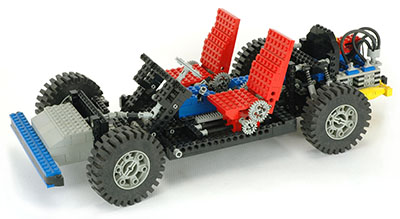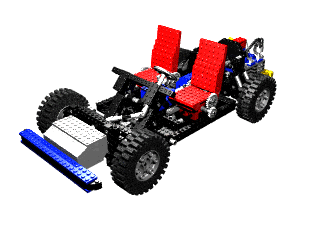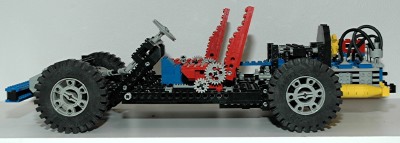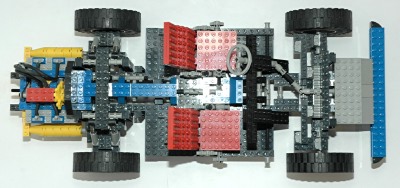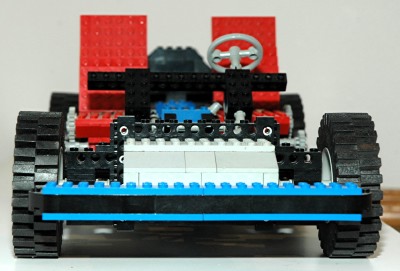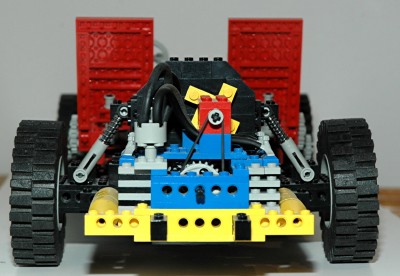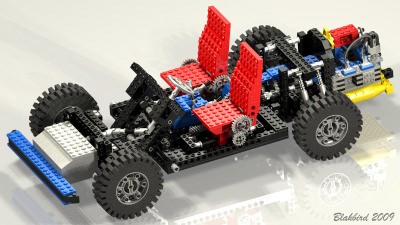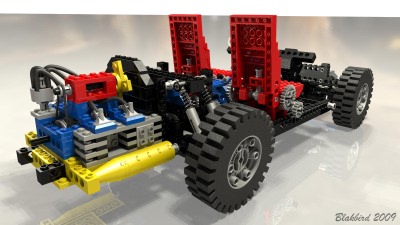Features
|
|
Steering
The front wheels can be steered using a wheel at the driver's
position. As can be seen in the computer generated image, the
wheel drives an axle connected to an 8 tooth pinion gear via a
pair of universal joints. The pinion drives a pair of
racks.
The racks use plates to
attach to the arms of the steering mechanism. The
steering mechanism itself uses 6
traditional 2x2 swivels with 2 pair allowing rotation of the wheels
about the vertical axis and another pair acting as steering arms
attached to the rack gear. Simple axles allow the wheels to
rotate freely.
This is the first Technic set in which the steering employs the
Ackerman Principle. You can see in the images that the tie rod
attachments are not directly behind the kingpins, but are one stud
inboard. The result of this is that the wheel on the inside of
the turn is rotated more sharply than the wheel on the outside, which
is exactly what is required for a turning in a proper circle without
skidding.
|
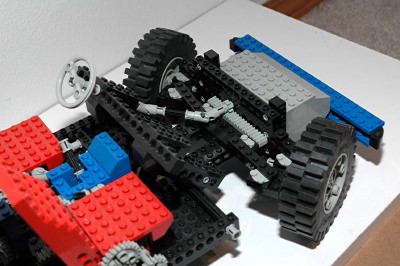
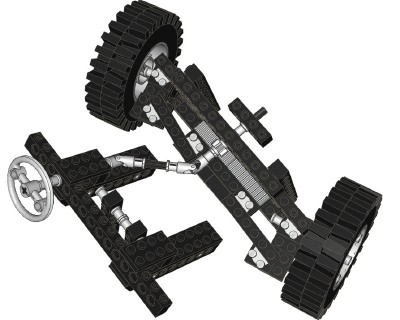
Click for an animation of the
steering in motion.
|
|
Engine and
Transmission
This set features a rear mounted 4-cylinder horizontally opposed
engine, similar to a "boxer" engine but with one crank pin per pair of
opposing cylinders.
The engine uses the offset axle holes of the 24 tooth gears to make a
crankshaft. Connectors placed end to end and clocked 90°
form rods which connect to 4 specialized 2x2 square pistons. The
"cylinders" are actually square. A belt on the rear of the
engine drives a fan.
The engine also has a number of aesthetic features such as cooling fins
(suggesting this engine is air cooled), a distributor, and a pair of
exhaust manifolds. There is also a bulkhead forward of the engine
which may be either a firewall or a radiator.
Ahead of the engine is a 3 speed gearbox / transmission (see color
coded computer
image). The green axle and 3 spur gears translate
forward and aft. The blue axle is driven by the engine and mates
with the crankshaft via a 24 tooth gear (not shown). The red axle
mates with the 28 tooth ring gear of the differential via the new 14
tooth bevel gear. In 3rd gear (pictured), the path to the wheels
is (8/24) x (24/8) x (8/24) x (28/14) = 1:1.5 (overdrive). In 2nd
gear, (8/24) x (24/8) x (16/16) x (28/14) = 2:1. In 1st gear,
(8/24) x (24/8) x (24/8) x (28/14) = 6:1.
The gearbox is not synchronized in any way, so it is difficult to shift
gears since they tend not to be aligned.
As you can see in the photograph, the shifter only allows two positions
(2nd and 3rd). 1st gear is locked out by blocking it with a
plate. This is due to the fact the gear ratio is so low that the
gear train cannot take the stress if the vehicle is pushed (engine
turns 6 times for every turn of the wheels) and tends to skip. If
the model is motorized (and therefore driven from the engine instead of
the wheels), the shifter is reversed to lock out 3rd instead, since 3rd
gear would tend to stall the electric motor.
|
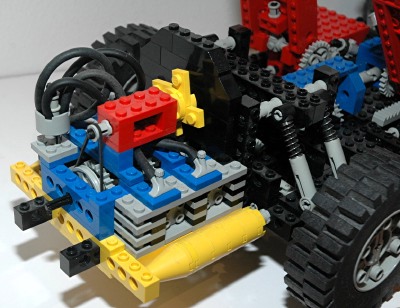
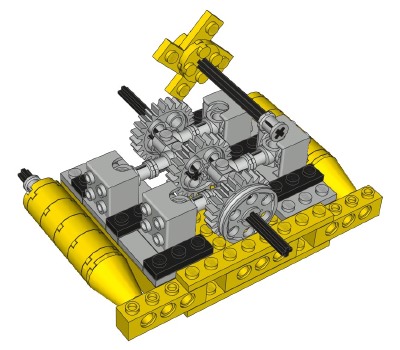
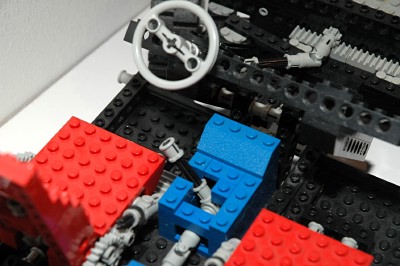
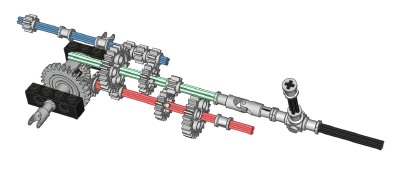
Click for an animation of the
engine
in motion.
|
|
Suspension
This is the first LEGO® set with suspension of any
kind. It is primitive but effective independent rear
suspension. The entire wheel assembly rotates with a cantilevered
lower control arm supported by a pair of new shock absorbers.
This is a swing axle type suspension which results in large
changes in wheel camber as the control arm is raised (see animation).
The wheel is driven through a universal joint. Since there is
only a single u-point, the rotational velocity of the wheel is not
constant, and becomes increasingly erratic at larger angles.
Luckily, the sprng weight of the vehicle is low enough that the control
arm is horizontal under normal load.
|
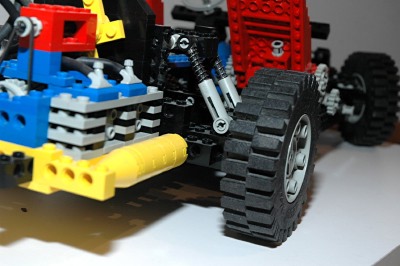
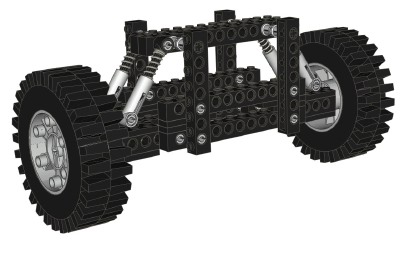
Click for an animation of the
suspension
in motion.
|
|
Differential
This is the first set with a real differential gear. It
incorporates a built in 28 tooth ring gear which can work either as a
bevel or a spur, similar to the 24 tooth crown gear. It is made
to house 3 of the new 14 tooth bevel gears. One is on each axle,
and one planet gear in the middle allows the axles to turn at different
rates. This addition results in very smooth turns for this model.
|
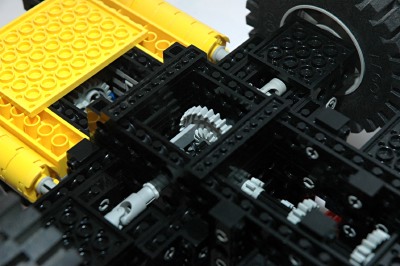
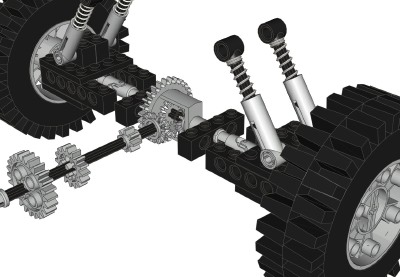
Click for an animation of the
differential
in motion. |
|
Seats
The bucket seats are among the most technical that LEGO®
ever made. A pair of longitudinal axles support each seat and
allow it to translate forward and back. A rack gear runs parallel
to the axles. A pinion gear attached to the seat can be turned
via a crank, driving the seat forward (see computer image and
animation).
In addition to the ability to adjust the position of the seats, these
seats also can be reclined! A second crank turns a set of 8 and
24 gears, one on the base and one on the seat back. A ratchet and
pawl, spring loaded by a rubber band, keep the seat from falling back
and lock it in any position.
There are no rear seats.
|
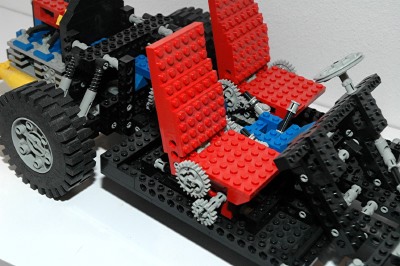
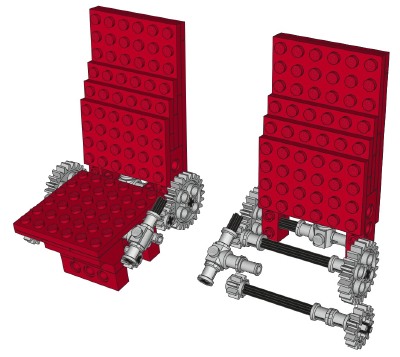
Click for an animation of the seats
translating.
Click for an animation of the seats
reclining.
|
|
Wheels and Tires
This set uses four foam 24x43 tires and wheels, the biggest
foam tire that LEGO® made.
|
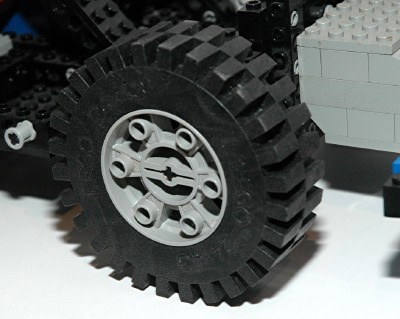
|

